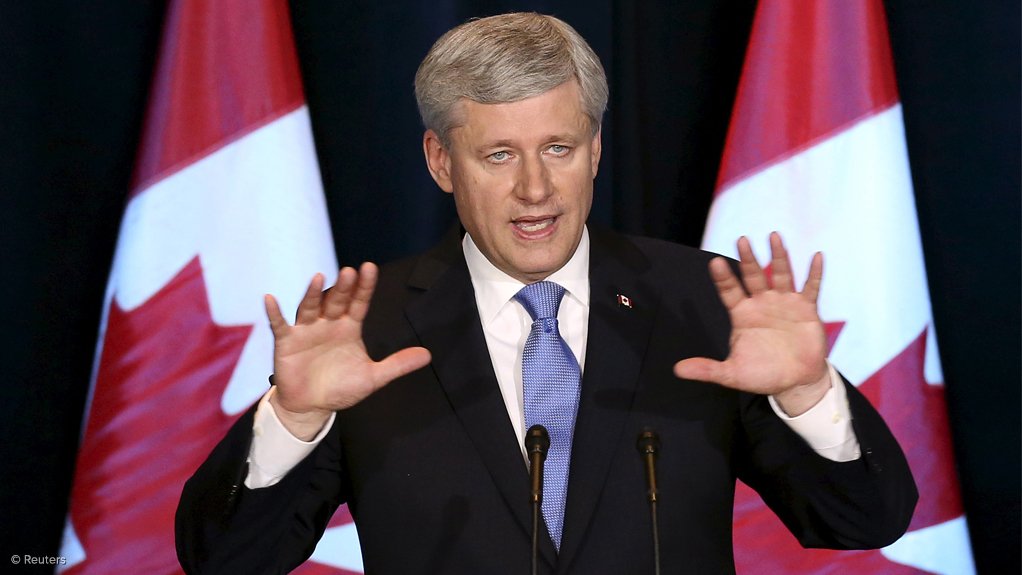Canada becomes founding partner of historic Trans-Pacific Partnership, to boost resource sectors


Canada's Prime Minister Stephen Harper speaks during a news conference on the TPP trade agreement, in Ottawa.
Photo by Reuters
TORONTO (miningweekly.com) – Canada on Monday became one of the 12 founders of the historic Trans-Pacific Partnership (TPP) free-trade agreement (FTA) that could ensure an increase in Canadian exports and investment to member countries, supporting jobs for Canadians at home and abroad.
The TPP was a multilateral trade agreement comprising 12 countries, including the US, Canada, Australia, Japan, Mexico, New Zealand, Singapore, Malaysia, Vietnam, Peru, Chile and Brunei Darussalam. Together, these countries represented a market of nearly 800-million consumers and a combined gross domestic product of about $28.5-trillion – nearly 40% of the global economy.
Billed as the most comprehensive trade agreement in the world, the TPP would help deepen Canada’s trade ties in the dynamic and fast-growing Asia-Pacific region, while strengthening existing economic partnerships with traditional partners in the North American Free Trade Agreement (Nafta) and across the Americas.
The TPP was expected to significantly improve market access opportunities for the industrial goods sector by eliminating all tariffs on Canada’s exports of industrial products, including metals and minerals, chemicals and plastics, industrial machinery, agricultural and construction equipment and information and communication technologies (ICTs).
The TPP agreement would give Canadian products preferential market access to TPP countries. It would provide new market access opportunities for Canadian metals and minerals, chemicals and plastics, ICT, life sciences, industrial machinery, agricultural equipment, construction equipment and cosmetics, among others. It would also ensure that Canadians had an advantage over competitors outside of the TPP, benefiting the entire sector, from producers to processors and in all regions of Canada.
The full text had not yet been released and the agreement would need to be ratified by the Parliaments and governments of all 12 countries before it would come into effect.
With the TPP, Canada had now concluded FTAs with 51 nations, ensuring Canadian businesses had access to more than 60% of the world’s economy. The TPP and trade agreements with the European Union and South Korea made Canada the only G-7 nation with free-trade access to the US and the Americas, Europe and the Asia-Pacific region.
Since 2006, Canada had concluded FTAs with no fewer than 39 countries, bringing the total to 44, making up more than half of the global economy and representing nearly one-quarter of the world’s countries.
RESOURCE BENEFITS
Canada, one of the most resource-rich countries in the world, was a leader in mineral exploration and mining, producing more than 60 minerals and metals domestically and operating in 100 countries around the world. The metals and minerals industry was a significant driver of the country's economic growth, contributing more than $164.8-billion to Canada’s gross domestic product (GDP) in 2014.
Canadian exports in this sector included petroleum products, potash and precious metals, such as gold and silver, as well as other metals, such as iron, steel, aluminium and nickel.
Examples of industrial goods tariffs that would be eliminated under the TPP under the metals and minerals section included Japan agreeing to cut tariffs of up to 11.7% or 44 yen/kg, whichever was less, within ten years. In Vietnam, tariffs of up to 40% would be eliminated within ten years, in Malaysia, tariffs of up to 50% would be eliminated within ten years, in Australia, tariffs of up to 5% would be eliminated within four years and in New Zealand, tariffs of up to 10% would be eliminated within seven years.
Under the TPP, iron and steel products would benefit from Japan eliminating tariffs of up to 6.3% within ten years, Vietnam eliminating tariffs of up to 40% within ten years, Malaysia eliminating tariffs of up to 25% within ten years and Australia cutting tariffs of up to 5% within four years.
Aluminium products would also receive a boost, with tariffs of up to 7.5% in Japan to be eliminated as soon as the deal came into force. In Vietnam, aluminium product tariffs of up to 27% would be scrapped within three years, while Malaysia would remove tariffs of up to 30% within a decade. In Australia, tariffs of up to 5% would be eliminated upon entry into force.
Further, nickel products would also benefit from Japan eliminating a 3% tariff within ten years. The country had also agreed to cut tariffs of up to 7.9% within ten years for petroleum products and Vietnam was expected to drop tariffs of up to 30% within the next decade.
MINING SUPPORT
As negotiators were ironing out the final details of the comprehensive deal, the Mining Association of Canada (MAC) last week expressed its firm support for Canada's participation in the TPP. "Canada's mining industry has been a strong advocate for liberalised trade and investment flows for many years. Nafta, free-trade agreements with Chile, Peru, Colombia and other countries in Latin America, Africa, and Asia, have all helped increase Canadian exports and investment,” president and CEO Pierre Gratton stated, adding that it was critical for Canada to be involved in such a massive trade block that included critical emerging markets.
Canada’s exports of metals and minerals to TPP countries were worth, on average, $158.6-billion a year between 2012 and 2014. Through the reduction of tariffs, operators in Canada stood to gain significantly with TPP partners.
For example, Japan currently applied tariffs of up to 7.9%, Vietnam of up to 40%, Malaysia of up to 50%, Australia of up to 5%, New Zealand of up to 10% and Brunei of up to 20%.
Extending beyond tariff elimination and reduction, the negotiations also addressed several challenges that companies currently grappled with in getting products, people and services across borders day-to-day. As mining was one of Canada’s largest outward investing sectors – accounting for 10% ($81.5-billion) of the 2013 total – benefiting from the greater certainty, transparency and foreign investment protection that the TPP would enable was important for the industry to remain competitive on the global stage, highlighted the MAC.
"The rest of the world looks to Canada as a leader when it comes to mining. Part of maintaining that global leadership is ensuring that the Canadian mining and supply sectors have access to modern and comprehensive trade and investment vehicles to meet the world where it does business,” Gratton said.
The Prospectors & Developers Association of Canada (PDAC) also affirmed its support for the historic agreement. “Access to international markets is vital for Canada’s mineral exploration and mining industry. Such a partnership is not only important for our industry, but also for Canada’s entire economy to have secure trading relationships with these countries,” PDAC president Rod Thomas stated last week.
The PDAC’s 8 000 members invested in significant financial assets across the Asia-Pacific region to explore for and develop mineral deposits. PDAC was particularly supportive of aspects of the TPP that would facilitate two-way investment, including protection for investors that provided greater clarity, certainty and transparency. The PDAC also supported TPP commitments that ensured sustainable development was a priority as it related to labour and the environment.
Comments
Press Office
Announcements
What's On
Subscribe to improve your user experience...
Option 1 (equivalent of R125 a month):
Receive a weekly copy of Creamer Media's Engineering News & Mining Weekly magazine
(print copy for those in South Africa and e-magazine for those outside of South Africa)
Receive daily email newsletters
Access to full search results
Access archive of magazine back copies
Access to Projects in Progress
Access to ONE Research Report of your choice in PDF format
Option 2 (equivalent of R375 a month):
All benefits from Option 1
PLUS
Access to Creamer Media's Research Channel Africa for ALL Research Reports, in PDF format, on various industrial and mining sectors
including Electricity; Water; Energy Transition; Hydrogen; Roads, Rail and Ports; Coal; Gold; Platinum; Battery Metals; etc.
Already a subscriber?
Forgotten your password?
Receive weekly copy of Creamer Media's Engineering News & Mining Weekly magazine (print copy for those in South Africa and e-magazine for those outside of South Africa)
➕
Recieve daily email newsletters
➕
Access to full search results
➕
Access archive of magazine back copies
➕
Access to Projects in Progress
➕
Access to ONE Research Report of your choice in PDF format
RESEARCH CHANNEL AFRICA
R4500 (equivalent of R375 a month)
SUBSCRIBEAll benefits from Option 1
➕
Access to Creamer Media's Research Channel Africa for ALL Research Reports on various industrial and mining sectors, in PDF format, including on:
Electricity
➕
Water
➕
Energy Transition
➕
Hydrogen
➕
Roads, Rail and Ports
➕
Coal
➕
Gold
➕
Platinum
➕
Battery Metals
➕
etc.
Receive all benefits from Option 1 or Option 2 delivered to numerous people at your company
➕
Multiple User names and Passwords for simultaneous log-ins
➕
Intranet integration access to all in your organisation



















